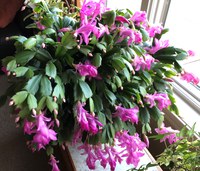Dakota Gardener: Don’t treat a Christmas cactus like a cactus
(Click an image below to view a high-resolution image that can be downloaded)
By Esther E. McGinnis, Horticulturist
NDSU Extension
A friend called me because she purchased a new Christmas cactus, and it wasn’t behaving the way she expected. Based on its cactus classification, she watered sparingly and placed the plant in direct sunlight. Despite this logical care regimen, the plant began to lose its flower buds and vigor. I had to inform my friend that the Christmas cactus is a plant with a confusing or even downright deceptive identity.
Yes, the Christmas cactus is in the cactus family, but you would be wrong if you envisioned a sunny desert origin for this plant. The parents of the modern Christmas cactus originated in the coastal mountains of Brazil. These mountains are covered in lush forests that receive high amounts of rainfall and humidity.
Surprisingly, the relatives of the Christmas cactus do not grow in the ground but have more in common with tropical orchids. They grow perched on shady tree branches. Rather than growing in the soil, their roots grow in decayed leaves and debris that have collected on tree branches. Frequent precipitation during the rainy season keeps the well-drained substrate moist.
Another deceptive aspect of this cactus is its name. The houseplant trade sells both Thanksgiving and Christmas cactuses around the winter holidays. The vast majority that are sold are actually Thanksgiving cactuses that are labeled as Christmas cactuses. Unfortunately, the true Christmas cactus is fragile and difficult to ship. You can differentiate the two by looking at the stem segments. Thanksgiving cactus has teeth or a spine-like edge to the stems. The true Christmas cactus will have more of a smooth, scalloped edge. Both types of cactus require the same care regimen.
Now that we know the plants’ origin, we know how to care for our holiday cactus. As a forest dweller, it likes bright light but not direct summer sun. Move the plant further away from the window if its stem segments start to redden or wilt.
Water varies by season. Once the flower buds form, water to keep the soil moist but not sopping wet. A good rule of thumb is to water when the top inch of potting soil feels dry. Humidity can be raised by grouping several houseplants together or by using a room humidifier. After flowering is complete, watering frequency can be reduced a bit for the winter but the potting soil must never be allowed to completely dry. More frequent watering and fertilizer applications can resume during the spring and summer months when the plant is actively growing.
To induce the plant to bloom starting in mid-September, expose the plant to cooler temperatures and long, dark nights. Fortunately, our homes are naturally cooler in the fall. To ensure optimum flowering, place the cactus in a spare room with a plant light on a timer, and give it eight hours of light and 16 hours of uninterrupted darkness per day. After six weeks, the plant may be returned to living areas and will bloom in time for the holidays.
NDSU Agriculture Communication – Dec. 6, 2022
Source: Esther McGinnis, 701-231-7406, esther.mcginnis@ndsu.edu
Editor: Elizabeth Cronin, 701-231-5391, elizabeth.cronin@ndsu.edu




